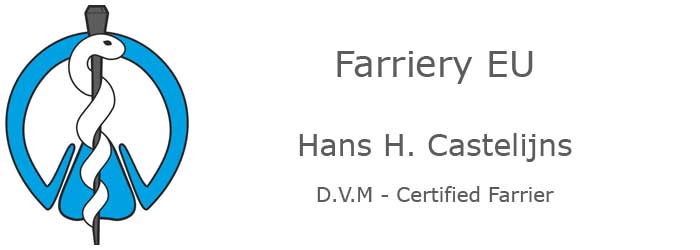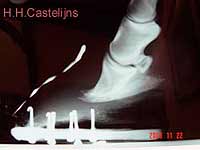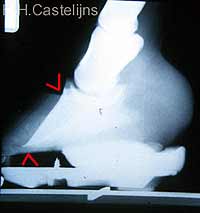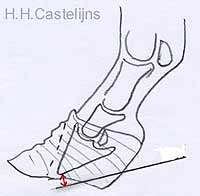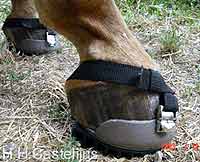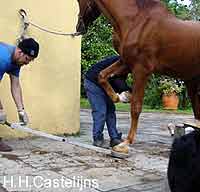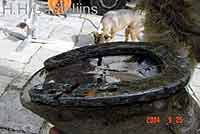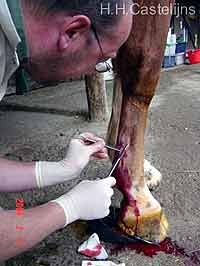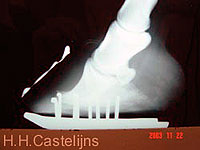Introduction:
When shoeing (sub)acute laminitis or founder cases, a sometimes controversial method concerns raising the heels, and then when to lower them again.(1,2,3)
Each and every patient with founder, defined as the loss of the normal spatial relationship between the distal phalanx (PIII) and the hoof capsule, has to be treated individually, sometimes each single hoof needs different shoeing, therefore one of the difficulties in shoeing laminitic and foundered horses is that it is hard to prescribe a standard type of shoeing for these horses. None the less a good understanding of the mechanical changes and effects of founder can help to decide which aspects of the shoeing are most important for a particular patient or hoof.
Heels: how much?
On a L.M. radiograph of the digit one can determine some parameters of interest in any foot, which become essential however in assessing foundered cases:
1) The distance(s) between the dorsal hoof wall and the dorsal aspect of PIII, its parallelism, or lack of it (capsular rotation).
2) The sole depth below the distal margin of PIII.
3) The distance between the extensor process of PIII and proximal border of the hoof capsule.
4) The angle known as palmar angle between the palmar (plantar) aspect of PIII and the ground surface of the hoof capsule.
5) The phalangeal alignment or lack of it (phalangeal rotation).
The main object of shoeing the sub acute laminitic or foundered horse is to prevent bone loss of the distal margin of PIII by maintaining or re-establishing sole depth under this margin (bone loss of PIII is irreversible).
The next objective in treating founder is to get a new, normally aligned and attached hoof capsule to grow back; that is to reserve capsular and digital rotation.
In the sagittal plane the alignment of the distal phalanx with the dorsal hoof capsule and with the proximal phalanxes is determined by the equilibrium between the laminar suspension on the, dorsal, “extension” side and pull of the deep digital flexor tendon (DDFT) on the “flexor” side.
In founder cases this equilibrium is broken, as the (dorsal) laminar attachment weakens and the DDFT pull causes capsular rotation under the weight of the horse. Another mechanism, which causes increased DDFT pull or DDFT shortening and thereby phalangeal rotation (broken forward digital axis), is pain.
DDFT pull can be diminished in three ways: by DDFT tenotomy, by raising the heels an by bringing dorsal break over back.
In acute - sub acute cases raising the heels can be a good emergency measure. This can be done by applying a cast, by slipping some wedges under the heels of the shoe, or by using a strap on shoe like the Dallmer Rehefix.
On chronic founder cases the horse has usually increased the palmar angle of PIII by growing more heel.
To realign the coffin bone to the digital axis you might have to trim the heels back quite a bit (“derotate” PIII). The increased tension of the DDFT can then be diminished by raised heel shoeing and/or by bringing the dorsal break over back.
To know how much to trim the heels, how much to raise the heels of the shoe and how far to set back dorsal break over, the following elements should be considered.
1) How many degrees of palmar angle do you want to bring down for digital alignment? E.g. for a 19° palmar angle you probably want an end result of 5-7°.
2) How much does the horse puts its heels down first?; the more a chronic case walks this way without pain the more you can bring down the heels, some chronic cases goe toe - first, meaning that severe D.D.F.T. contracture has taken place.
3) How much dorsal extension on a board or on a digital extension device can you get without signs of pain? If the horse jumps of the board at 15-20° elevation, you know you cannot increase DDFT pull much. (Normal dorsal extension varies but measures around 30-46°).
4) How much new, well-aligned dorsal hoof wall have you got beneath the coronary band ? If you start getting 3-4 cm of good, well aligned dorsal hoof wall proximally, you start getting a decent laminar counter force to DDFT pull.
In all cases of trimming the heels (or lowering the heels by removing previous wedges) setting the dorsal break over back becomes tremendously important.
In the author's experience, failure to do this is one of the most common shoeing problems in foundered horses. It is for instance very common to see a reserve shoe whose intent is good but which is to long at the toe.
The dorsal break over point can and often should, be brought back all the way to the projection of the extensor process of PIII.
Another method of achieving a gradual lowering of the heels to diminish phalangeal rotation is to apply a shoe with what has been called a “self adjusting palmar angle” (Redden) or “air wedge”(Stephan Becker).
Basically this consist of forging a shoe with two planes on its ground surface, a dorsal plane, which is more inclined, and a palmar plane which is better aligned with the bottom surface of PIII. This permits the horse to stand “steeper” on the dorsal ground surface and to extend the distal interphalangeal joint gradually by standing / walking on the palmar ground surface of the shoe.
In the case of chronic shortening and pain of the DDFT (horses goes on their toes and are still painful after abaxial palmar digital nerve blocks), DDFT tenotomy might be the only option left, in this case it is advisable to trim the heels and shoe with ample palmar support before tenotomy, as otherwise the hoof risks tipping back (hyperextend).
Conclusion:
There are no hard and fast rules on how aggressively and for how long to raise heels, when and by how much the palmar angle should be lowered. Before lowering the heels of a foot with a large palmar angle of PIII, testing for the capacity of dorsal extension is useful. Setting back the dorsal break over point (and not letting it grow forward by long shoeing intervals) is always indicated when lowering the heels (unless a DDFT tenotomy is performed).
